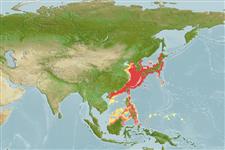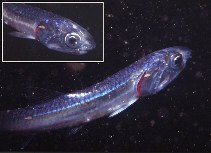Add your observation in Fish Watcher
| Native range | All suitable habitat | Point map | Year 2050 |

|
| This map was computer-generated and has not yet been reviewed. |
| Engraulis japonicus AquaMaps Data sources: GBIF OBIS |
Upload your photos and videos
Pictures | Google imageEngraulis japonicus
Picture by Zsilavecz, G.
Pictures | Google imageEngraulis japonicus
Picture by Zsilavecz, G.
China country information
Common names:
姑仔, 姑仔, 日本鯷
Occurrence: native
Salinity: marine
Abundance: | Ref:
Importance: highly commercial | Ref: FAO, 1994
Aquaculture: | Ref:
Regulations: | Ref:
Uses: no uses
Comments: Known from Bohai in Liaoning Province (Ref. 47439) and from Yantai City and Qingdao City in Shandong Province (Ref. 47439). Also Ref. 559, 42692, 117610.
National Checklist:
Country Information: https://www.cia.gov/library/publications/resources/the-world-factbook/geos/ch.html
National Fisheries Authority:
Occurrences: Occurrences Point map
Main Ref: Whitehead, P.J.P., G.J. Nelson and T. Wongratana, 1988
National Database:
Occurrence: native
Salinity: marine
Abundance: | Ref:
Importance: highly commercial | Ref: FAO, 1994
Aquaculture: | Ref:
Regulations: | Ref:
Uses: no uses
Comments: Known from Bohai in Liaoning Province (Ref. 47439) and from Yantai City and Qingdao City in Shandong Province (Ref. 47439). Also Ref. 559, 42692, 117610.
National Checklist:
Country Information: https://www.cia.gov/library/publications/resources/the-world-factbook/geos/ch.html
National Fisheries Authority:
Occurrences: Occurrences Point map
Main Ref: Whitehead, P.J.P., G.J. Nelson and T. Wongratana, 1988
National Database:
Common names from other countries
Classification / Names आम नाम | उपशब्द | Catalog of Fishes(वर्ग, प्रजाति) | ITIS | CoL | WoRMS | Cloffa
> Clupeiformes (Herrings) > Engraulidae (Anchovies) > Engraulinae
Etymology: Engraulis: Greek, eggraulis, -eos = anchovy (Ref. 45335).
More on authors: Temminck & Schlegel.
Etymology: Engraulis: Greek, eggraulis, -eos = anchovy (Ref. 45335).
More on authors: Temminck & Schlegel.
Environment: milieu / climate zone / depth range / distribution range पारिस्थितिकी
समुद्री; औशिनोड़िरोमस (Ref. 51243); गहराई सीमा 0 - 400 m (Ref. 50550). Temperate; 8°C - 30°C (Ref. 56557); 49°N - 2°N, 105°E - 155°E (Ref. 54432)
वितरण देश | ऐफ ऐ ओ क्षेत्र | Ecosystems | संयोग | Point map | भूमिका | Faunafri
Western Pacific: southern Sakhalin Islands, Sea of Japan and Pacific coasts of Japan, and south to almost Canton/Taiwan; rare records (seems to represent stray fishes) off the coasts of Luzon and Western Mindanao, Philippines and from Manado and Ujung Pandang, Sulawesi, Indonesia (Ref. 189).
Length at first maturity / आकार / वज़न / Age
Maturity: Lm 10.5, range 10 - 11 cm
Max length : 18.0 cm TL पुल्लिंग / अलिंग; (Ref. 56527); common length : 14.0 cm TL पुल्लिंग / अलिंग; (Ref. 56527); अधिकतम प्रकाशित वज़न: 45.00 g (Ref. 56527); अधिकतम सूचित उम्र: 4 वर्षो (Ref. 56527)
Max length : 18.0 cm TL पुल्लिंग / अलिंग; (Ref. 56527); common length : 14.0 cm TL पुल्लिंग / अलिंग; (Ref. 56527); अधिकतम प्रकाशित वज़न: 45.00 g (Ref. 56527); अधिकतम सूचित उम्र: 4 वर्षो (Ref. 56527)
Short description पहचान कुंजी | आकृति विज्ञान | मौरफोमैटरिक्स
पृष्ठीय रीढ़ (सम्पूर्ण) : 0; पृष्ठीय सौफट रेज़ (सम्पूर्ण) : 12 - 14; गुदा कांटा: 0; ऐनल सौफट रेज़: 13 - 18. Differs very little from the European anchovy (see E. encrasicolus) and can be identified from that description. Of other anchovies found in the southern part of its distribution, only species of Encrasicholina and Stolephorus are of similar appearance, but all have small spine-like pre-pelvic scutes (usually 2 to 7 scutes). Thryssa have compressed bodies and a keel of scutes along belly.
Occurs in large schools near the surface, mainly in coastal waters but as far out as over 1,000 km from the shore. Tends to move more northward and inshore in spring and summer. Juveniles associate with drifting seaweed (Ref. 12114, 12115). Feeds on copepods, but also on other small crustaceans, molluscan larvae, fish eggs and larvae and diatoms. Marketed fresh and salted, processed into fishmeal and oil (Ref. 12484).
Life cycle and mating behavior परिपक्व अवधि | पुनरुत्पत्ति | मछलीऔ का अंडे देना | अंडे | Fecundity | लार्वा
Main reference
Upload your references | संदर्भ | संयोजक | सहयोगीयो
Whitehead, P.J.P., G.J. Nelson and T. Wongratana, 1988. FAO Species Catalogue. Vol. 7. Clupeoid fishes of the world (Suborder Clupeoidei). An annotated and illustrated catalogue of the herrings, sardines, pilchards, sprats, shads, anchovies and wolf-herrings. FAO Fish. Synop. 125(7/2):305-579. Rome: FAO. (Ref. 189)
Human uses
मात्स्यिकी: उच्च वाणिज्य; जलीयकृषि: व्यापारिक; ठहराव / प्रलोभन: usually
FAO(मात्स्यिकी: production, species profile; publication : search) | FishSource | Sea Around Us
अधिक जानकारी
Population dynamics
Growth parameters
Max. ages / sizes
Length-weight rel.
Length-length rel.
Length-frequencies
Mass conversion
भर्ती
बहुतायत
Growth parameters
Max. ages / sizes
Length-weight rel.
Length-length rel.
Length-frequencies
Mass conversion
भर्ती
बहुतायत
Life cycle
पुनरुत्पत्ति
परिपक्व अवधि
Fecundity
मछलीऔ का अंडे देना
Spawning aggregations
अंडे
Egg development
लार्वा
लारवल गतिकी
पुनरुत्पत्ति
परिपक्व अवधि
Fecundity
मछलीऔ का अंडे देना
Spawning aggregations
अंडे
Egg development
लार्वा
लारवल गतिकी
Anatomy
गिल क्षेत्र
Brain
Otolith
गिल क्षेत्र
Brain
Otolith
Physiology
Body composition
Nutrients
Oxygen consumption
Swimming type
Swimming speed
Visual pigments
Fish sound
Diseases & Parasites
Toxicity (LC50s)
Body composition
Nutrients
Oxygen consumption
Swimming type
Swimming speed
Visual pigments
Fish sound
Diseases & Parasites
Toxicity (LC50s)
Human related
Aquaculture systems
जलीयकृषि रूपरेखाऐ
खींच
Ciguatera cases
Stamps, coins, misc.
Aquaculture systems
जलीयकृषि रूपरेखाऐ
खींच
Ciguatera cases
Stamps, coins, misc.
साधन
Bio-Quiz | E-book | कार्यक्षेत्र पथप्रदर्शक | पहचान कुंजी | लंबाई आवृति इंद्रजालिक | जीवन-इतिहास उपकरण | बिन्दु नक्शा | Classification Tree
| Catch-MSY |
Special reports
Download XML
Summary page | Point data | आम नाम | Photos
इंटरनेट स्रोत
Aquatic Commons | BHL | Cloffa | BOLDSystems | Websites from users | Check FishWatcher | CISTI | Catalog of Fishes(वर्ग, प्रजाति) | DiscoverLife | ECOTOX | Faunafri | Fishtrace | GenBank(genome, nucleotide) | GloBI | GOBASE | | Google Books | Google Scholar | Google | IGFA World Record | MitoFish | राष्ट्रीय आंकड़ासंचय | Otolith Atlas of Taiwan Fishes | PubMed | Reef Life Survey | Scirus | SeaLifeBase | Tree of Life | Wikipedia(Go, खोज) | World Records Freshwater Fishing | Zoobank | Zoological Record
Estimates based on models
Preferred temperature (Ref. 115969): 8.1 - 23.3, mean 18.4 (based on 139 cells).
Phylogenetic diversity index (Ref. 82804): PD50 = 0.5020 [Uniqueness, from 0.5 = low to 2.0 = high].
Bayesian length-weight: a=0.00398 (0.00272 - 0.00583), b=3.10 (2.98 - 3.22), in cm Total Length, based on LWR estimates for this species & Genus-body shape (Ref. 93245).
Trophic level (Ref. 69278): 3.1 ±0.1 se; based on diet studies.
लौटाव (Ref. 120179): ऊंचा, न्यूनतम जनसंख्या दुगनी समय अवलागत 15 महीने। (K=1.05; tm=1-2; tmax=3).
Prior r = 0.90, 95% CL = 0.60 - 1.36, Based on 3 full stock assessments.
Fishing Vulnerability (Ref. 59153): Low vulnerability (23 of 100).




